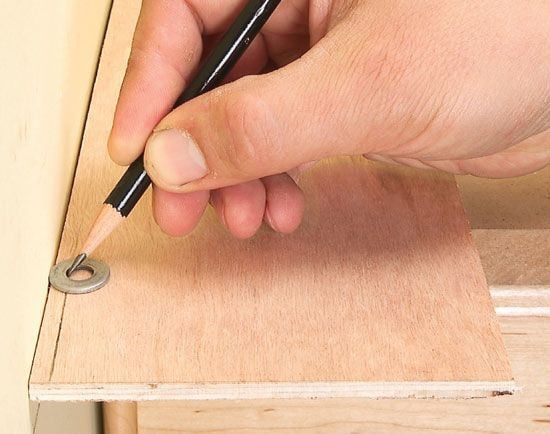Woodworking is a craft that requires precision and attention to detail. One of the key elements in achieving professional-looking results is understanding and mastering angles. Whether it’s creating clean corner joints, angled edges, or intricate joinery, accurate angle calculations are essential for establishing seamless connections and ensuring a tight fit.
The importance of angles in woodworking cannot be overstated. They not only contribute to the aesthetic appeal of the finished project but also determine its structural integrity. Proper angle measurements lead to cohesive joinery, where pieces fit together seamlessly without gaps or misalignments. This level of precision is crucial for both functional and decorative woodworking projects.
In woodworking, there are many types of angles that are used depending on the desired outcome. From standard right angles to complex compound curves, each angle serves a specific purpose in creating different joints and shapes. By understanding these various types of angles and how they contribute to woodworking techniques, craftsmen can expand their design possibilities and elevate their craftsmanship.
In the following sections, we will delve into the nitty-gritty of figuring angles in woodworking. We will start with the basics, such as understanding angular measurements and utilizing tools like protractors and bevel gauges for accurate measurements.
Then, we will explore calculating angles for basic joints such as miters and bevels before moving on to more advanced angle calculations for intricate joinery like dovetails. Finally, we will tackle curved woodworking projects, troubleshooting common challenges with angle measurement, exploring alternative tools and techniques, and enhancing woodworking skills through practice and repetition.
Whether you’re a beginner woodworker looking to grasp the essentials or an experienced craftsman striving for perfection, this comprehensive guide will equip you with the knowledge and techniques necessary to master the art of figuring angles in woodworking. Get ready to dive deep into this fundamental aspect of woodworking that holds the key to achieving flawless results in every project you undertake.
The Basics
In the world of woodworking, understanding angular measurements is essential for achieving precision and accuracy in your projects. Whether you’re working on a simple corner joint or a complex compound curve, having a solid grasp of angles will ensure seamless joinery and professional-looking results. In this section, we will cover the basics of angular measurements in woodworking, including common measurement units, the significance of right angles, and the tools you can use to accurately measure angles.
When it comes to measuring angles in woodworking, degrees and radians are the most commonly used units of measurement. Degrees are often represented by the symbol “°” and are divided into 360 equal parts. Radians, on the other hand, are based on circles and are measured based on the radius of that circle. One full rotation around a circle is equal to 2π radians or approximately 6.28 radians.
One angle that plays a crucial role in woodworking is the right angle, which measures exactly 90 degrees. Right angles are especially important because they serve as a reference for many other angles within woodworking projects. They provide stability and precise alignment when joining two pieces together at corners or creating perpendicular edges.
To accurately measure angles in your woodworking projects, there are several tools you can utilize. Protractors are commonly used for measuring and marking specific angles. They come in various designs, such as circular protractors for measuring smaller angles and digital protractors with an LCD screen for precise measurements.
Bevel gauges allow you to set an angle directly from an existing surface or edge by sliding along it and locking at your desired angle. Angle finders are also helpful tools that can determine both acute and obtuse angles by clamping onto two surfaces or edges.
By understanding common measurement units for angles and utilizing tools like protractors, bevel gauges, and angle finders, you’ll be well-equipped to accurately measure and mark the necessary angles for your woodworking projects. The next section will delve into how to calculate angles for basic joints, such as miters and bevels, ensuring clean and precise connections.
Calculating Angles for Basic Joints
When it comes to woodworking, accurately cutting and joining pieces at the correct angles is crucial for achieving seamless and professional-looking results. This section will focus on calculating angles for two common types of joints: miters and bevels.
Determining and Cutting Accurate Miter Angles
Miter joints are commonly used in projects such as picture frames, door frames, and furniture corners. To create a clean and tight miter joint, it is essential to accurately determine the angle at which the two pieces will meet. Here are the steps to follow:
- Measure the inside or outside dimensions of the project that requires a miter joint.
- Halve that measurement to find the length of each piece that needs to be cut.
- Use a protractor or an angle finder tool to determine the precise angle needed for your particular miter joint.
- Transfer the angle onto your workpiece by aligning your measuring tool with one edge of the wood and marking the desired angle.
- Carefully cut along your marked line using a miter saw or another appropriate woodworking tool.
Understanding Bevel Angles
Bevel angles are crucial when creating angled edges or compound joints in woodworking projects. The process of calculating bevel angles may differ depending on your specific project, but here are some general guidelines:
- Determine whether you need an internal or external bevel angle based on how you want your angled edge or joint to look.
- Measure the thickness of your workpiece that will receive the bevelled edge or commonly known as chamfer.
- Using a bevel gauge or an adjustable sliding bevel, set the tool to the desired angle of your bevel.
- Transfer the angle from your measuring tool to your workpiece by aligning the tool with one edge and marking the cut line.
- Safely make the bevel cut using a table saw, hand plane, or other appropriate woodworking tools.
By accurately calculating and cutting miter and bevel angles, you will ensure tight-fitting joints and create visually pleasing results in your woodworking projects. Practice these techniques on scrap wood before working on your main project to build proficiency and confidence in cutting accurate angles for basic joints.
Advanced Angle Calculations
Creating complex joinery in woodworking requires advanced angle calculations to ensure precise and secure fitting joints. In this section, we will explore more intricate joints, such as dovetails, finger joints, and mortise and tenon connections. We will also discuss methods for calculating and transferring angles between pieces for seamless joinery.
When it comes to complex joinery, one commonly used joint is the dovetail joint. This type of joint utilizes interlocking angled cuts that create a strong connection between two pieces of wood. The angles for dovetails vary depending on the desired aesthetic and functional requirements.
Accurately measuring and transferring these angles from one piece to another is crucial for a tight-fitting joint. Specialized tools such as dovetail markers can aid in marking out the correct angles, ensuring precision during cutting.
Another commonly used joint in complex woodworking projects is the finger joint, which involves interlocking rectangular cuts. Like dovetails, finger joints rely on accurate angle calculations to achieve a secure fit. By determining the correct angles for both the fingers and slots, you can create a visually appealing joint that is structurally sound. Utilizing tools such as angle gauges or miter saws with adjustable stops can help ensure consistency when cutting these precise angles.
Mortise and tenon connections are also frequently used in woodworking to create sturdy joinery. This technique involves creating a slot (mortise) in one piece of wood that corresponds with a projecting tongue (tenon) on another piece. Calculating the correct angles is essential to ensure a snug fit between the mortise and tenon components. While there are various ways to mark out and cut these angles accurately, some woodworkers prefer using specialized jigs or templates for efficiency and consistency.
| Joint Type | Methods for Accurate Angle Calculations |
|---|---|
| Dovetail Joint | – Utilize dovetail markers to mark out angles accurately. |
| Finger Joint | – Use angle gauges or adjustable miter saws with stops for precise cuts. |
| Mortise and Tenon Connection | – Consider using specialized jigs or templates to ensure consistency. |
With these advanced angle calculations, woodworkers can confidently create complex joinery that showcases their skill and craftsmanship. By mastering these techniques, a woodworker can achieve flawless connections in even the most intricate projects.
Conquering Angles in Curved Woodworking Projects
In the world of woodworking, angles play a crucial role not only in creating straight and precise joints but also in achieving stunning curved designs. This section will focus on conquering angles in curved woodworking projects, specifically bent lamination and compound curves.
Bent lamination involves gluing together thin strips of wood to create strong and flexible curved shapes. Calculating and shaping the angles correctly is essential for successful bent lamination. To calculate the angles for bent laminations, you’ll need to determine the desired radius and thickness of the curve.
One method is using a bending formula or a calculator designed specifically for bent lamination. Once you have the accurate measurements, you can begin cutting and shaping the individual strips of wood accordingly.
Compound curves, on the other hand, are combinations of multiple curves that create intricate designs with dynamic visual appeal. These curves require careful calculation and layout to achieve perfect symmetry and flow. When working with compound curves, it is important to understand how different angles affect each other when combined. By breaking down complex curves into smaller segments and calculating the individual angles for each segment, you can then transfer those measurements onto your workpiece accurately.
| Topic | Information |
|---|---|
| Bent Lamination | – Gluing thin strips of wood
|
| Compound Curves | – Combination of multiple curves
|
By mastering angle calculations in curved woodworking projects, you can unlock endless possibilities for creativity and innovation. Whether you’re working on bent laminations or compound curves, the precision achieved through accurate angle calculations will greatly contribute to the overall beauty and functionality of your woodworking projects. So don’t shy away from exploring curved designs, and embrace the challenge of conquering angles in your woodworking journey.
Troubleshooting Angles
Common Mistakes and Pitfalls
In woodworking, measuring and cutting angles can sometimes be challenging, leading to common mistakes and pitfalls. One of the most frequent errors is inaccurate measurement, which can result in misaligned joints and compromised overall project quality. It is crucial to understand the potential challenges that may arise and learn how to troubleshoot them effectively.
A common mistake occurs when using a protractor or angle finder incorrectly. These tools should be used with precision, ensuring that they are aligned properly with the workpiece. Deviating even slightly from the correct angle can lead to significant errors in the final joint. Additionally, not accounting for factors such as wood movement or material thickness can cause inaccuracies in angle calculations. It is important to consider these variables when determining angles for different woodworking joints.
Troubleshooting Misaligned Joints
Misaligned joints are a common issue that arises due to incorrect angle calculations or inaccurate cutting. When faced with misaligned joints, there are several solutions available to correct the problem. One approach is adjusting the angles by sanding or trimming the pieces until they fit snugly together. However, this method may compromise the overall strength and integrity of the joint if excessive material removal is required.
Another solution is to create custom shims by layering thin strips of wood between the pieces to compensate for any angular discrepancies. This technique allows for precise adjustments while maintaining joint strength. Additionally, applying clamps or using specialized jigs during assembly can help realign misaligned joints by exerting pressure in specific areas.
Tips and Tricks for Accuracy and Consistency
To ensure accuracy and consistency when working with angles in complex projects, there are several tips and tricks that can greatly enhance woodworking skills:
- Double-check measurements: Always verify measurements before making cuts or adjustments.
- Use marking gauges: Utilize marking gauges to transfer or replicate angles consistently across multiple workpieces.
- Make test cuts: Before cutting into the actual project material, practice on scrap pieces to ensure proper angle calculations and cutting techniques.
- Establish a reference face or edge: When working with multiple pieces, designate a reference face or edge to ensure consistent alignment and accurate angle measurements.
- Take your time: Rushing through angle calculations and cuts can lead to errors. Take the necessary time to measure accurately and make precision cuts.
By incorporating these troubleshooting tips and tricks into woodworking practices, woodworkers can overcome common challenges associated with angles and achieve precise joinery in their projects.
Alternative Tools and Techniques for Angle Measurement in Woodworking
In addition to traditional tools like protractors, bevel gauges, and angle finders, there are alternative tools and techniques available that can aid woodworkers in achieving precise angle measurements. These tools provide different advantages and may be particularly useful in specific situations or for individuals who prefer a more modern approach. This section will explore some of these alternative tools and techniques for angle measurement in woodworking.
Digital Angle Gauges
One alternative tool that has gained popularity among woodworkers is the digital angle gauge. These compact devices utilize electronic sensors to measure angles with a high degree of accuracy. Digital angle gauges typically feature easy-to-read LCD screens that display the measured angle in degrees, providing a convenient way to obtain precise measurements quickly.
Digital angle gauges offer several advantages over traditional tools. Firstly, they eliminate the need for manual alignment and calibration, as they automatically zero themselves when placed on a flat surface or against a reference edge. This ensures consistent and accurate measurements each time. Additionally, many digital angle gauges can hold their readings so that woodworkers can easily transfer angles between pieces.
Laser Guides
Another modern tool that can assist with accurate angle measurement is the laser guide. Laser guides project a visible beam onto the workpiece, allowing woodworkers to precisely align cuts or mark angles without relying on physical measuring tools.
Laser guides are particularly helpful when working with large or irregularly shaped pieces where traditional measuring methods may be challenging or inaccurate. Woodworkers can simply align the laser beam with the desired cut line or reference point to ensure precise and consistent results.
However, it’s important to note that while laser guides provide an excellent visual reference, they do not automatically measure angles themselves. Woodworkers still need to use conventional measuring techniques in combination with laser guides to ensure accurate measurements.
Apps for Angle Measurements
With the rise of smartphones and technology, there are now apps available that can aid woodworkers in measuring angles. These apps utilize the built-in sensors of smartphones to provide angle measurements quickly and conveniently.
Angle measurement apps are typically easy to use, with intuitive interfaces that display the measured angle in degrees or radians. Some apps even offer advanced features like the ability to measure slope angles or create custom angle presets.
While smartphone apps may not be as precise as dedicated tools, they can be a handy option for quick measurements or when traditional measuring tools are unavailable. It’s important to calibrate these apps properly before use to ensure accurate results.
By incorporating alternative tools and techniques into their woodworking practice, woodworkers can enhance their angle measurement capabilities and achieve even greater precision and accuracy in their projects. Whether utilizing digital angle gauges, laser guides, or smartphone apps, these tools can complement traditional methods and make the process of measuring angles more efficient and convenient for woodworkers.
Enhancing Woodworking Skills
Woodworking is a craft that requires meticulous attention to detail and precision, and mastering the art of angle calculations is essential for achieving professional-looking results. This section will focus on enhancing woodworking skills by emphasizing the importance of practicing and perfecting angle calculations. By dedicating time to improving your angle measurement abilities, you can greatly enhance your woodworking projects and take them to the next level.
Importance of Practice in Mastering Angle Calculations
Just like any other skill, mastering angle calculations requires practice and repetition. The more you engage in measuring and cutting angles accurately, the better you will become at it. Regular practice will help improve your understanding of different types of angles and measurement units, as well as increase your familiarity with the various tools used for precise measurements.
To sharpen your skills, consider incorporating dedicated practice sessions into your woodworking routine. These sessions can consist of exercises that specifically target different aspects of angle calculations, such as determining miter angles or transferring angles between pieces. Additionally, it can be helpful to work on small projects that allow you to apply your knowledge and skills in real-world scenarios.
Recommended Exercises and Projects
There are several exercises and projects that can help strengthen your angle measurement skills:
- Create a simple box with mitered corners: Practice determining accurate miter angles for clean corner joints.
- Build a small table with compound joinery: This project will require calculating both miter and bevel angles for creating angled edges.
- Construct a dovetail jointed drawer: Explore more intricate joinery techniques by calculating dovetail angles accurately.
These exercises will not only challenge you to calculate angles but also provide opportunities to troubleshoot any errors or misalignments that may occur along the way. As you complete these projects, take note of areas where you struggled or made mistakes, and use those experiences as learning opportunities to improve your angle calculation skills.
Resources and References
To further enhance your woodworking abilities with angles, there are various resources and references available. Books on joinery and woodworking techniques often provide valuable insights into angle calculations, offering in-depth explanations and step-by-step instructions for specific joints. Online platforms and forums dedicated to woodworking can also serve as excellent sources of information, allowing you to learn from experienced woodworkers who have mastered the intricacies of angle calculations.
In addition to traditional resources, there are also alternative tools and techniques that can aid in precise angle measurements. Digital angle gauges, laser guides, and smartphone apps can supplement traditional measurement tools by providing accurate readings and visual aids. While these tools can be useful, it is important to understand their limitations and continue practicing with manual methods to develop a thorough understanding of angles.
By dedicating time to practice and explore additional resources, you will steadily improve your angle calculation skills in woodworking. Remember that mastering this crucial aspect of woodworking takes time and patience, but the rewards are well worth the effort. As you continue honing your abilities, you will gain the confidence to tackle more complex projects with precision and achieve flawless joinery results.
Conclusion
In conclusion, mastering the art of angle calculations in woodworking is essential for achieving precision and accuracy in your projects. By understanding the various types of angles used in woodworking and knowing how to accurately measure and calculate them, you can ensure seamless joinery and professional-looking results.
Throughout this article, we have covered the basics of angular measurements, including common units such as degrees and radians, as well as the significance of right angles in woodworking. We have also explored tools and techniques for accurate angle measurements, such as protractors, bevel gauges, and angle finders.
But it doesn’t end there. We have delved deeper into calculating angles for basic joints like miters and bevels, providing detailed instructions and tips for achieving tight-fitting connections. We have also discussed advanced angle calculations for creating more complex joinery, showcasing specialized tools that facilitate accurate measurements in intricate projects.
Furthermore, we have explored angles in curved woodworking projects like bent laminations and compound curves. By learning how to calculate and shape angles in these projects, you can take your woodworking skills to a whole new level. Additionally, we have addressed common challenges when working with angles in woodworking and provided troubleshooting tips to help you overcome them.
Ultimately, by practicing and perfecting your angle calculation skills through proposed exercises and projects, you can enhance your woodworking abilities. The satisfaction that comes with achieving precise and flawless angle joinery is unmatched. So don’t be afraid to apply the knowledge you’ve gained from this article in future woodworking endeavors – embrace the challenge of mastering angles for beautiful, professional-grade results.
Frequently Asked Questions
How do you measure angles in woodworking?
In woodworking, angles are commonly measured using a tool called a protractor. A protractor is a semi-circular instrument with markings from 0 to 180 degrees on its curved edge.
To measure an angle, the protractor is placed so that the center point aligns with the vertex of the angle and one of its straight edges lies along one of the angle’s sides. The measurement can then be determined by reading the degree marked on the protractor where the second side intersects.
How do you figure out an angle?
Finding an angle often depends on the specific information available about the angle or its surrounding elements. If two lines or segments intersect, causing an angle to form, you can use a protractor to measure directly as described earlier.
However, if you have other given information such as side lengths or angles created within geometric shapes such as triangles or quadrilaterals, trigonometric functions like sine, cosine, or tangent can be used to calculate unknown angles using formulas specific to those scenarios.
How do you find the angle of a miter cut?
The angle of a miter cut can be found by considering two intersecting pieces that join at a specific angle when creating a corner joint in carpentry or picture framing, for example. One common method involves using a miter gauge or miter saw which allows precise cutting at various angles.
Usually calibrated in degrees from 0° to 45° on either side of 90° (the right angle), these tools provide accurate measurements for making both square and non-square angles cuts. By adjusting the miter gauge accordingly and aligning it with a reference line on your workpiece, you can achieve an accurate miter cut at your desired angle.

Hi everyone! I’m a woodworker and blogger, and this is my woodworking blog. In my blog, I share tips and tricks for woodworkers of all skill levels, as well as project ideas that you can try yourself.





